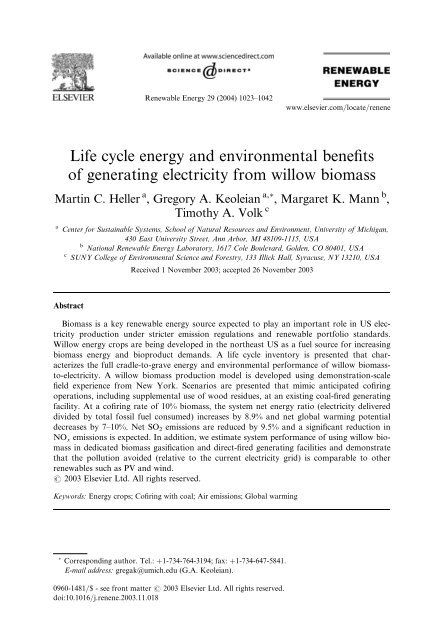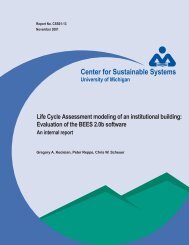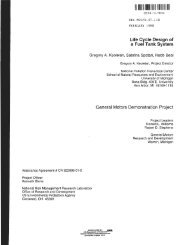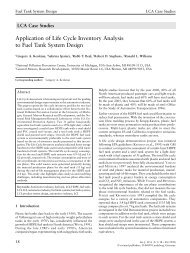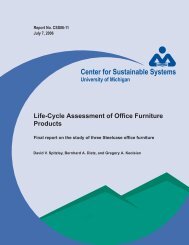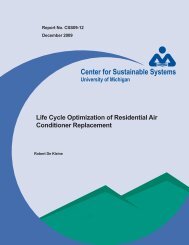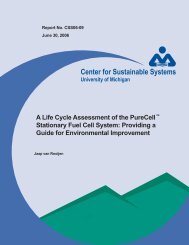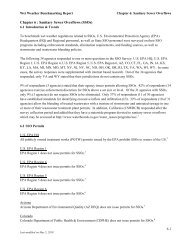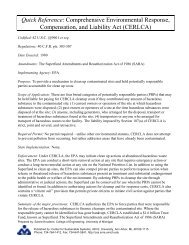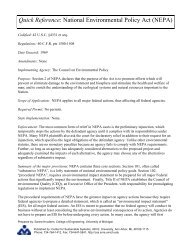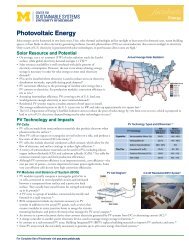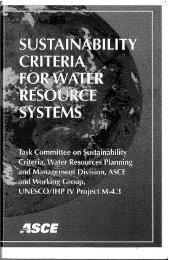Life cycle energy and environmental benefits of ge... - ResearchGate
Life cycle energy and environmental benefits of ge... - ResearchGate
Life cycle energy and environmental benefits of ge... - ResearchGate
Create successful ePaper yourself
Turn your PDF publications into a flip-book with our unique Google optimized e-Paper software.
M.C. Heller et al. / Renewable Energy 29 (2004) 1023–10421031Table 4Dunkirk Unit #1 baseline air emissions (no c<strong>of</strong>iring)CompoundEmission (kg/MWh net electricity)CO 2 932.1NO x (as NO 2 ) 1.583SO 2 15.022CO 0.105VOC 0.012Particulates 0.135Ash (dry) 31.62additional reduction in NO x emissions due to the higher volatility <strong>and</strong> moisturecontent <strong>of</strong> biomass. Correlations presentedby Tillman predict a 16.1% <strong>and</strong>26.4%reduction in NO x emissions at 10% <strong>and</strong>15% c<strong>of</strong>ire (<strong>energy</strong> basis), respectively [28].These effects depend lar<strong>ge</strong>ly on boiler configuration <strong>and</strong> operation, however. Sinceemissions data are not currently available for c<strong>of</strong>iring in the Dunkirk boiler, wepresent NO x emissions cases basedon ‘‘fuel-boundeffects’’ <strong>and</strong>compare them withresults basedon Tillman’s correlation.2.4. Estimates <strong>of</strong> dedicated biomass electricity <strong>ge</strong>neration <strong>and</strong> comparison with otherrenewablesIn order to consider the performance <strong>of</strong> a dedicated willow biomass electricity<strong>ge</strong>nerating system, the willow biomass production <strong>and</strong> transportation models werelinkedto sets <strong>of</strong> power plant emission factors for biomass gasification <strong>and</strong>directfiredoperations.Specifiedconversion efficiencies were usedto establish feedstock(i.e. willow biomass) production <strong>and</strong> transportation flows that were then combinedwith power plant emissions (Table 5) to provide rough estimates <strong>of</strong> system performance.Note that these estimates do not include power plant construction <strong>and</strong>decommissioning or additional operational dem<strong>and</strong>s <strong>of</strong> the power plant.Table 5Dedicated biomass power plant emission dataNREL gasification a EPRI gasification b EPRI direct-fired bConversion efficiency 37.2% 36% 27.7%Emission factors (g/MWh elec )CO 0.86 206 2019NMHC 515.5 96 269.2NO x 479 645 67.3Particulates3.7 na na(unspecified)SO 2 254 818 naa [29].[21].
1032M.C. Heller et al. / Renewable Energy 29 (2004) 1023–1042Results from willow gasification <strong>and</strong>direct-firedscenarios are presentedin terms<strong>of</strong> the pollution prevention achievedrelative to US ‘‘composite kWh’’ avera<strong>ge</strong> gridelectricity <strong>ge</strong>neration. Data for this avera<strong>ge</strong> grid<strong>ge</strong>neration are from the DEAMdatabase <strong>and</strong> includes production, combustion, <strong>and</strong> waste mana<strong>ge</strong>ment <strong>of</strong> the fivemain fuels in the following proportions (1996 values): coal (56.6%), nuclear (22%),hydroelectricity (10.6%), natural gas (8.6%), heavy fuel oil (2.2%).For comparison, avoided pollution realized across the life <strong>cycle</strong> <strong>of</strong> two otherimportant renewable <strong>energy</strong> sources, building-integrated photovoltaic (BIPV) <strong>and</strong>wind-powered electricity <strong>ge</strong>neration, are presented. The BIPV system is anamphorous silicon PV with a 6% conversion efficiency affixedto a st<strong>and</strong>ing seamro<strong>of</strong> locatedin New York, NY. A description <strong>of</strong> the life <strong>cycle</strong> inventory analysis ispresentedin Keoleian <strong>and</strong>Lewis [30]. The wind-powered <strong>ge</strong>neration system presentedisa 9 MW (18500 kW units) l<strong>and</strong>-based Danish wind farm analyzed bySchleisner [31]. Avoided pollution is again presented relative to avera<strong>ge</strong> US gridelectricity <strong>ge</strong>neration.3. Results3.1. Biomass c<strong>of</strong>iring3.1.1. Energy analysisGenerating electricity with coal alone consumes 11,496 MJ/MWh elec across thefull life <strong>cycle</strong>, 93% <strong>of</strong> which is coal useddirectly at the plant. Due to the lar<strong>ge</strong>quantity <strong>of</strong> coal processed, upstream <strong>energy</strong> consumption (i.e. <strong>energy</strong> not useddirectly as fuel at the plant) is dominated by coal mining, transportation, <strong>and</strong> losses(Fig. 2). Substituting biomass for coal decreases this <strong>energy</strong> consumption somewhat,but also introduces additional upstream <strong>energy</strong> consumption in producing thebiomass. As a result, total upstream <strong>energy</strong> consumption remains nearly unchan<strong>ge</strong>dwith c<strong>of</strong>iring. Note that if coal haul losses are not included, upstream <strong>energy</strong> consumptionfor the no-c<strong>of</strong>ire case decreases to 273 MJ/MWh elec , while the residue/willow blend<strong>and</strong>all-willow c<strong>of</strong>ire are 320 <strong>and</strong>304 MJ/MWh elec , respectively.Net <strong>energy</strong> ratio, defined as the electricity produced by the system divided by thetotal fossil fuel <strong>energy</strong> consumed, is a useful indicator <strong>of</strong> system performance. Thenet <strong>energy</strong> ratio for the no-c<strong>of</strong>ire case is 0.313. This increases to 0.341 with 10%c<strong>of</strong>iring, with very little difference in net <strong>energy</strong> ratio between the two c<strong>of</strong>iringscenarios.3.1.2. Global warming potentialIn our model, <strong>ge</strong>nerating electricity from coal alone releases 978 kg CO 2 eq./MWh, 95% <strong>of</strong> which is releasedin the form <strong>of</strong> CO 2 at the power plant. Mining <strong>and</strong>transportation <strong>of</strong> the coal compose the balance, contributing 42.8 <strong>and</strong>7.6 kg CO 2eq./MWh, respectively. Fig. 3 demonstrates how the greenhouse gas emissions aredistributed in the c<strong>of</strong>iring scenarios. GHG emissions from coal mining, transport,<strong>and</strong> combustion are reduced by replacing coal with biomass during c<strong>of</strong>iring. CO 2absorbedin the growing <strong>of</strong> willow biomass is creditedto the system in the ‘‘willow
M.C. Heller et al. / Renewable Energy 29 (2004) 1023–10421033Fig. 2. Distribution <strong>of</strong> upstream <strong>energy</strong> consumption (<strong>energy</strong> not useddirectly as fuel in the powerplant) for biomass c<strong>of</strong>iring.production’’ step, but is directly <strong>of</strong>fset by the willow biomass contribution in‘‘power plant emissions’’, resulting in a neutral contribution. Contributions <strong>of</strong> CO 2emissions from tractor operation during willow production, as well as N 2 O emissionsfrom fertilizedagricultural soils, are relatively small (see [10] for details).While the system is not credited for CO 2 absorption during the growth <strong>of</strong> woodyresidues, a credit is taken for l<strong>and</strong>fill methane <strong>and</strong> CO 2 emissions avoided in utilizingthe residues in c<strong>of</strong>iring.Replacing the specific ‘‘furniture residues’’ case with more <strong>ge</strong>neric residue biomass<strong>and</strong> national-avera<strong>ge</strong> l<strong>and</strong>fill statistics has a modest impact on overall systemGHG emissions (Table 6). The <strong>ge</strong>neric residue has a lower heating value <strong>and</strong> thusgreater carbon content per MJ, resulting in increasedstack CO 2 emissions. Sinceless methane is combustedin the ‘‘<strong>ge</strong>neric’’ l<strong>and</strong>fill scenario, methane emissionsincrease <strong>and</strong>CO 2 from biomass (resulting from combustion <strong>of</strong> methane) decreases.On the other h<strong>and</strong>, a lar<strong>ge</strong>r fraction <strong>of</strong> the combusted l<strong>and</strong>fill methane is used forelectricity <strong>ge</strong>neration in the national-avera<strong>ge</strong> scenario. Since this LFG <strong>ge</strong>neration isreplaced in the model with grid electricity when l<strong>and</strong>fill disposal is avoided, there isa corresponding increase in fossil CO 2 emissions (from gridelectricity <strong>ge</strong>neration).3.1.3. Air emissionsC<strong>of</strong>iring biomass provides a significant reduction in SO 2 emissions, due to thevery low sulfur content <strong>of</strong> biomass (Fig. 4). This reduction chan<strong>ge</strong>s little with biomasstype (Table 7). NO x emissions predictions based on fuel-bound N demon-
1034M.C. Heller et al. / Renewable Energy 29 (2004) 1023–1042Fig. 3. Distribution <strong>of</strong> greenhouse gas emissions by life <strong>cycle</strong> sta<strong>ge</strong>s <strong>and</strong>contributing gas species.strate an increase in NO x emissions when c<strong>of</strong>iring the furniture residue/willowblend(Fig. 4, Table 7). This is due to the high nitro<strong>ge</strong>n content <strong>of</strong> the furniturewood residues. A 5% reduction in total system NO x emissions is realizedwith a10% c<strong>of</strong>ire <strong>of</strong> all willow (Table 7). The <strong>ge</strong>neric residue scenario provides a similarTable 6Greenhouse gas emissions (kg CO 2 eq./MWh elec ) for the ‘‘<strong>ge</strong>neric’’ residue scenario, with 10% c<strong>of</strong>iring<strong>of</strong> residue/willow blend. Values in parentheses are percent chan<strong>ge</strong> from the ‘‘specific’’ residue scenarioTotal system Residue transport Avoided residuedisposalPower plantemissionsCumulative total 909.6 (0.4%) 0.8 (80.7%) 76.8 (8.8%) 948.4 (1.0%)CO 2 (biomass) 865.1 (23.8%) 0.0 (80.7%) 17.9 ( 27.5%) 109.5 (9.9%)CO 2 (fossil) 852.6 (0.0%) 0.7 (80.7%) 0.7 ( 41.0%) 838.9 (0.0%)CH 4 29.9 (71.1%) 0.0 (80.7%) 59.6 (26.4%) 0 (0.0%)
M.C. Heller et al. / Renewable Energy 29 (2004) 1023–10421035Fig. 4. Distribution <strong>of</strong> air emissions across life <strong>cycle</strong> sta<strong>ge</strong>s for c<strong>of</strong>iring <strong>of</strong> biomass with coal.reduction in NO x emissions due to low N content <strong>of</strong> the biomass (data not shown).The empirical correlation presentedby Tillman [28] predicts a 16.1% reduction instack NO x emissions at a 10% c<strong>of</strong>ire. This results in total system emissions <strong>of</strong> 1440
Table 7Total system air pollutants, global warming potential, <strong>and</strong> net <strong>energy</strong> ratio for biomass c<strong>of</strong>iring, dedicated willow biomass electricity <strong>ge</strong>neration, <strong>and</strong>otherrenewable <strong>energy</strong> sourcesCO(g CO/MWh elec )NO x(g NO 2 /MWh elec )SO 2(g SO 2 /MWhelec)Non-methanehydrocarbons(g/MWhelec)Particulates(unspecifiedsize)(g/MWhelec)Global warmingpotential (kg CO 2eq./MWhelec)Net <strong>energy</strong>ratio10% c<strong>of</strong>ire, residue/ 152 ( 3.2%) 1870 (9.7%) 13,700 ( 9.6%) 84.1 ( 10.1%) b 708 (–6.3%) 906 ( 7.4%) 0.341willow blend a10% c<strong>of</strong>ire, all willow160 (1.7%) 1610 ( 5.2%) 13,700 ( 9.5%) 86.4 ( 7.6%) b 706 (–6.6%) 883 ( 9.9%) 0.342aAvera<strong>ge</strong> US grid c 417 3330 3210 44.1 2140 989 0.257Willow production <strong>and</strong> transport with... dNREL gasifier 69.9 ( 83.2%) 645 ( 80.6%) 374 ( 88.3%) 525 (1090%) 34.0 (–98.4%) 38.9 ( 96.1%) 13.3EPRI gasifier 277 ( 33.5%) 817 ( 75.5%) 942 ( 70.6%) 106 (139%) >31.4 (–98.5%) e 40.2 ( 96.0%) 12.9EPRI direct-fired 1770 (324%) 279 ( 91.6%) >161 ( 95.0%) e 236 (435%) >40.8 (–98.1%) e 52.3 ( 94.7%) 9.9BIPV d 43.3 ( 89.6%) 248 ( 92.6%) 512 ( 84.0%) 67.5 (53.0%) 575 (–73.1%) 59.4 ( 94.0%) f 43Wind d na 30 ( 99.1%) 20 ( 99.4%) na na 9.7 ( 99.0%) h 30.3abcdeghParentheses are percent chan<strong>ge</strong> relative to coal-only (no c<strong>of</strong>ire) operation.Biomass contribution to stack emissions not available.TEAM database, version 3.0 (Ecobalance).Parentheses are percent chan<strong>ge</strong> relative to avera<strong>ge</strong> US grid.Power plant stack emissions not specified; values shown are from feedstock production <strong>and</strong> transportation only.BIPV, building-integrated photovoltaic. Ref. [30].[31].Global warming potential contains CO 2 contributions only.f1036M.C. Heller et al. / Renewable Energy 29 (2004) 1023–1042
M.C. Heller et al. / Renewable Energy 29 (2004) 1023–10421037<strong>and</strong>1456 g NO x /MWh for the residue/willow blend <strong>and</strong> the all-willow scenario,respectively (15% <strong>and</strong>14% system reduction relative to no c<strong>of</strong>ire, respectively).The model also predicts a roughly 6% reduction in particulate emissions with10% c<strong>of</strong>iring, all <strong>of</strong> which is realizedthrough reducedcoal mining operation (Fig. 4,Table 7). However, the model assumes that there is no chan<strong>ge</strong> in power plant particulateemissions with c<strong>of</strong>iring <strong>of</strong> biomass.C<strong>of</strong>iring biomass also provides significant reductions in mercury emissions.Metal analysis <strong>of</strong> willow biomass indicates an avera<strong>ge</strong> mercury content <strong>of</strong> 0.005mg/odkg [14] (Hg content not available for residue biomass). Assuming that allthe biomass-derived Hg volatilizes during combustion, a 10% c<strong>of</strong>ire <strong>of</strong> all willowwouldreduce the system air emissions <strong>of</strong> Hg by 8.4%. Contributions <strong>of</strong> mercuryfrom willow production are negligible. Note that there is a potential for biomass tocontain other heavy metals <strong>of</strong> concern. Metal content in the biomass is a function<strong>of</strong> metal concentrations in the soil where the crop is grown <strong>and</strong>tree uptakeefficiency [32,33].3.2. Dedicated willow biomass electricity <strong>ge</strong>neration in comparison with otherrenewablesTable 7 also contains the estimated emissions for dedicated willow biomass toelectricity system, using both direct-fired <strong>and</strong> gasification conversion technologies.In these scenarios, it is assumedthat willow biomass supplies all <strong>of</strong> the feedstock<strong>energy</strong> to the power plant. Emissions from the production <strong>and</strong> transportation <strong>of</strong>willow are combinedwith power plant emission factors containedin Table 5. Significantpollution prevention (relative to the current US electricity grid) is realizedwith biomass-<strong>ge</strong>neratedelectricity. The high net <strong>energy</strong> ratios demonstrate the fossil<strong>energy</strong> leveraging <strong>of</strong> a renewable <strong>energy</strong> source. For example, 13 units <strong>of</strong> electricityare <strong>ge</strong>neratedfor every one unit <strong>of</strong> fossil <strong>energy</strong> consumedacross the full life<strong>cycle</strong> <strong>of</strong> willow gasification.Comparisons with example LCAs <strong>of</strong> other renewable <strong>energy</strong> technologies revealthat biomass affords relatively similar levels <strong>of</strong> avoided pollution (Table 7). Biomassoutperforms BIPV from an <strong>energy</strong> perspective (as well as the closely correlatedglobalwarming potential) but does not score as well as wind<strong>ge</strong>neration. Itshould be noted, however, that these studies do not take into account the powerfluctuation <strong>of</strong> the different <strong>ge</strong>nerating systems. Both wind <strong>and</strong> solar are intermittentsources, while biomass permits continual base load<strong>ge</strong>neration.4. DiscussionC<strong>of</strong>iring biomass with coal provides numerous <strong>environmental</strong> <strong>benefits</strong>. While theupstream <strong>energy</strong> consumedin growing or processing <strong>and</strong>transporting biomassroughly balances the reduced consumption from mining, processing, <strong>and</strong> transportingless coal (Fig. 2), the system realizes an overall benefit through reduced fossilfuel consumption at the power plant (reduced coal use), which is reflected inincreasednet <strong>energy</strong> ratios. C<strong>of</strong>iring also imparts reductions in system greenhouse
1038M.C. Heller et al. / Renewable Energy 29 (2004) 1023–1042effect that scale with the c<strong>of</strong>iring rate, although our model demonstrates that theextent <strong>of</strong> these reductions can be dependent on the source <strong>and</strong> type <strong>of</strong> biomass aswell as the modeling procedure adopted.Willow biomass is grown specifically for electricity <strong>ge</strong>neration <strong>and</strong>thus willowproduction is considered to be within the power <strong>ge</strong>neration system boundary. As aresult, electricity <strong>ge</strong>neration with willow biomass is nearly GHG neutral (40–50 kgCO 2 eq./MWh elec ). However, the original growth <strong>of</strong> residue biomass is not consideredwithin the power <strong>ge</strong>neration system boundary <strong>and</strong> a CO 2 absorption creditis not taken for the growth <strong>of</strong> this biomass. Utilizing biomass residues for electricity<strong>ge</strong>neration avoids other means <strong>of</strong> disposal (in this case, l<strong>and</strong>fill) <strong>and</strong> in turnavoids the GHG emissions that would have occurred as a result <strong>of</strong> that disposal.While not all <strong>of</strong> the carbon in the residue biomass decomposes to gaseous productsin our l<strong>and</strong>fill model, methane <strong>ge</strong>neration through anaerobic decomposition contributesstrongly to the net greenhouse effect due to methane’s relatively highequivalent global warming potential (GWP CH4 ¼ 23 kg CO 2 eq./kg CH 4 [8]).Decomposition <strong>of</strong> 100 kg <strong>of</strong> residue biomass in the ‘‘specific residue’’ l<strong>and</strong>fill scenarioreleases 127.2 kg total CO 2 eq., whereas complete aerobic decomposition (orcomplete combustion) releases 181.9 kg CO 2 . Thus, in this situation, l<strong>and</strong>filled biomasshas a lower global warming potential than combustion, but there is a significantloss <strong>of</strong> potential for power <strong>ge</strong>neration. Under the ‘‘specific’’ l<strong>and</strong>fill scenario,100 kg <strong>of</strong> biomass <strong>ge</strong>nerates 0.03 kWh electricity through l<strong>and</strong>fill gas capture butthe same 100 kg <strong>of</strong> biomass represents 132 kWh <strong>of</strong> <strong>ge</strong>neration potential in a c<strong>of</strong>iringoperation. Comparison <strong>of</strong> the different residue scenarios indicates that smallchan<strong>ge</strong>s in biomass characteristics, transportation distances, <strong>and</strong> disposal mana<strong>ge</strong>mentcan influence the resulting greenhouse gas benefit. Under the ‘‘<strong>ge</strong>neric’’ l<strong>and</strong>fillscenario, 100 kg <strong>of</strong> biomass leads to 166.2 kg total CO 2 eq. A previous reportthat considered a combination <strong>of</strong> residue disposal through l<strong>and</strong>fill <strong>and</strong> utilizationas mulch foundthat disposal <strong>of</strong> 100 kg <strong>of</strong> biomass releases 248.2 kg total CO 2 eq.[13]. Clearly, such allocation procedures must be st<strong>and</strong>ardized if they are to beusedin CO 2 emission regulation <strong>and</strong>/or trading.C<strong>of</strong>iring biomass reduces emissions <strong>of</strong> SO 2 , Hg, <strong>and</strong>(in most cases) NO x . Theextent to which biomass c<strong>of</strong>iring will reduce NO x remains case-specific, as it isdependent on not only biomass composition but also boiler configuration <strong>and</strong>operating conditions. Dedicated biomass <strong>ge</strong>neration, which in new power plantswill most likely use gasification technology, also provides significant reductions inSO 2 ,NO x , <strong>and</strong>Hg emissions relative to the current coal-dominatedelectricity mix.Recent forecasts by the Energy Information Administration at the US Department<strong>of</strong> Energy predict little to no addition <strong>of</strong> biomass-powered electricity <strong>ge</strong>neration,or indeed any renewable <strong>energy</strong> sources, when tightened three-pollutant(NO x , SO 2 , Hg) regulations are adopted [4]. Power <strong>ge</strong>nerators are expectedtoinsteadchoose the less expensive option <strong>of</strong> installing emission control equipmentwhile maintaining coal as the primary fuel source. However, cases that considerstrin<strong>ge</strong>nt CO 2 reductions or aggressive RPS predict significant increases in the use<strong>of</strong> biomass, both in c<strong>of</strong>iring operations <strong>and</strong> dedicated biomass power plants. WhenaCO 2 cap at 7% below the 1990 level is assumed, biomass c<strong>of</strong>iring is predicted to
M.C. Heller et al. / Renewable Energy 29 (2004) 1023–10421039increase to 50 billion kWh by 2020, more than 700% above the Annual EnergyOutlook reference case. Adopting the goal <strong>of</strong> 20% RPS by 2020 is forecasted toincrease total biomass-fueled<strong>ge</strong>neration to 526 billion kWh by 2020, with 85% <strong>of</strong>this from dedicated power plants. Under this 20% RPS scenario, biomass composes10% <strong>of</strong> the total electricity <strong>ge</strong>neration [4].Establishing <strong>energy</strong> crops, <strong>of</strong> course, requires arable l<strong>and</strong>, <strong>and</strong> there is concernover the availability <strong>of</strong> this limited resource. According to our model, supplyin<strong>ge</strong>nough willow to support a 10% c<strong>of</strong>ire <strong>of</strong> all willow at the Dunkirk facility wouldrequire an estimated2925 ha <strong>of</strong> plantation. This is 2.5% <strong>of</strong> the open l<strong>and</strong>with suitablesoils <strong>and</strong> slopes for willow biomass production within an 83 km radius aroundthe Dunkirk plant (note that Dunkirk is on the shore <strong>of</strong> Lake Erie, so much <strong>of</strong> thearea aroundthe plant is unavailable) [34]. Operating a 100 MW gasifier at 37%efficiency <strong>and</strong>80% capacity wouldrequire 26,865 ha <strong>of</strong> willow plantation, or only1.3% <strong>of</strong> the total area within an 80 km radius. In an exp<strong>and</strong>ed biomass <strong>energy</strong>market, however, willow <strong>energy</strong> crops will be one <strong>of</strong> many biomass sources includingurban, agricultural, <strong>and</strong>forestry residues <strong>and</strong>other <strong>energy</strong> crops such asswitchgrass. A recent EIA report estimates that 3.9–5.8 million ha <strong>of</strong> <strong>energy</strong> cropswill be needed to meet the 20% RPS by 2020 projection [6]. The report also pointsout that it is possible to grow biomass <strong>energy</strong> crops on Conservation Reserve Program(CRP) l<strong>and</strong>, <strong>and</strong> that this projected <strong>energy</strong> crop acrea<strong>ge</strong> represents 24–37%<strong>of</strong> the current allowable CRP l<strong>and</strong>. In addition, acrea<strong>ge</strong> devoted to farms <strong>and</strong> rancheshas been declining steadily since the 1950s [35]. Thus, l<strong>and</strong>use for biomass<strong>energy</strong> crops is not expectedto conflict with l<strong>and</strong>requirements for food<strong>and</strong>feedcrop production.5. Conclusions<strong>Life</strong> <strong>cycle</strong> analysis demonstrates that electricity <strong>ge</strong>neration with willow <strong>energy</strong>crops, either by c<strong>of</strong>iring with coal or in dedicated biomass power plants, leads tosignificant reductions in many <strong>of</strong> the <strong>environmental</strong> impacts <strong>of</strong> coal-based electricityproduction. Consumption <strong>of</strong> non-renewable resources (coal) is reduced, asare net greenhouse gas emissions <strong>and</strong>criteria air pollutants including SO 2 , Hg, <strong>and</strong>likely, NO x . C<strong>of</strong>iring biomass at 10% increases the net <strong>energy</strong> ratio <strong>of</strong> producin<strong>ge</strong>lectricity by 8.9%. Similarly, the net <strong>energy</strong> ratio for dedicated biomass gasificationis estimated to be 13, indicating that 13 units <strong>of</strong> electricity are produced forevery unit <strong>of</strong> fossil <strong>energy</strong> consumedacross the entire system life <strong>cycle</strong>. For comparison,the net <strong>energy</strong> ratio <strong>of</strong> the current US electricity gridis 0.26.This study sug<strong>ge</strong>sts that the <strong>environmental</strong> impacts from producing electricitywith willow biomass <strong>energy</strong> crops are similar to using woody residues <strong>and</strong> that thepollution preventedis comparable to other renewable <strong>energy</strong> sources (solar <strong>and</strong>wind). Additional data <strong>and</strong> experience are needed to determine whether the smalldifferences reported here are indeed significant. It should be noted that choice <strong>of</strong>modeling parameters <strong>and</strong> allocation procedures can have significant effects onresults. <strong>Life</strong> <strong>cycle</strong> assessment basedon ISO 14040 guidelines <strong>of</strong>fers a validmeans <strong>of</strong>
1040M.C. Heller et al. / Renewable Energy 29 (2004) 1023–1042quantifying potentially regulated<strong>and</strong>/or tradable emissions such as SO 2 ,NO x ,<strong>and</strong>greenhouse gases, but additional st<strong>and</strong>ardization will be needed to assure consistency.The current study presents results useful for evaluating biomass electricity<strong>ge</strong>neration as an emerging technology as well as forwarding the discussion <strong>of</strong>method st<strong>and</strong>ardization.In addition to the <strong>environmental</strong> <strong>benefits</strong> quantified in this LCA, willow biomasscrops will provide other <strong>benefits</strong> as they are deployed across the l<strong>and</strong>scape. Theseinclude rural development through the creation <strong>of</strong> new markets <strong>and</strong> jobs, enhancedl<strong>and</strong>scape diversity <strong>and</strong> wildlife habitat, <strong>and</strong> reduced erosion potential. Such <strong>benefits</strong>,while important features <strong>of</strong> willow biomass crops, are not readily captured bylife <strong>cycle</strong> methodology.Market-basedforecasts show that the multiple <strong>benefits</strong> <strong>of</strong> renewable <strong>energy</strong> fuelsources such as willow biomass will not be realizedwithout proper regulatory orlegislative incentive. While other less costly options exist to reduce air pollutantsfrom existing fossil fuel power plants, biomass <strong>energy</strong> presents an opportunity toreduce air pollutants while also cutting greenhouse gas emissions <strong>and</strong> loweringnon-renewable <strong>energy</strong> consumption.Acknowled<strong>ge</strong>mentsThis research is funded by a postdoctoral fellowship grant from the NationalResearch Initiative Competitive Grants Program <strong>of</strong> the UnitedStates Department<strong>of</strong> Agriculture (USDA Awardno. 00-35314-09998).References[1] Energy Information Administration. Analysis <strong>of</strong> strategies for reducing multiple emissions fromelectric power plants with advanced technology scenarios. Washington, DC: US Department <strong>of</strong>Energy; 2001. Report No.: SR/OIAF/2001-05.[2] Energy Information Administration. Impacts <strong>of</strong> a 10-percent renewable portfolio st<strong>and</strong>ard.Washington DC: US Department <strong>of</strong> Energy; 2002. Report No.: SR/OIAF/2002-03. Availablefrom: http://www.eia.doe.gov/oiaf/servicerpt/rps/pdf/sroiaf(2002)03.pdf.[3] Energy Information Administration, US Department <strong>of</strong> Energy. Annual Energy Review 2000.Washington, DC; 2001. Report No.: DOE/EIA-0384(2000). Available from: http://tonto.eia.doe.-gov/FTPROOT/multifuel/038400.pdf.[4] Energy Information Administration. Analysis <strong>of</strong> strategies for reducing multiple emissions fromelectric power plants: sulfur dioxide, nitro<strong>ge</strong>n oxides, carbon dioxide, <strong>and</strong> mercury <strong>and</strong> a renewable<strong>energy</strong> portfolio st<strong>and</strong>ard. Washington, DC: US Department <strong>of</strong> Energy; 2001. Report No.: SR/OIAF/2001-03. Available from: http://www.eia.doe.gov/oiaf/servicerpt/epp/pdf/sroiaf(2001)03.pdf.[5] Energy Information Administration. Impacts <strong>of</strong> the Kyoto protocol on US <strong>energy</strong> markets <strong>and</strong>economic activity. Washington, DC: US Department <strong>of</strong> Energy; 1998. Report No.: SR/OIAF/98-03. Available from: http://www.eia.doe.gov/oiaf/kyoto/kyotorpt.html.[6] Haq Z. Biomass for electricity <strong>ge</strong>neration. Washington, DC: Energy Information Administration,US Department <strong>of</strong> Energy; 2002. Available from: http://www.eia.doe.gov/oiaf/analysispaper/biomass/pdf/biomass.pdf.
M.C. Heller et al. / Renewable Energy 29 (2004) 1023–10421041[7] International Organization for St<strong>and</strong>ardization. Environmental mana<strong>ge</strong>ment—life <strong>cycle</strong> assessment—principles<strong>and</strong>framework. Geneva; 1997. Report No.: ISO 14040.[8] Houghton JT, Filho LGM, Bruce J, Lee H, Call<strong>and</strong>er BA, Haites E, et al., editors. Radiative forcing<strong>of</strong> climate chan<strong>ge</strong> <strong>and</strong>an evaluation <strong>of</strong> the IPCC IS92 emissions scenarios. Cambrid<strong>ge</strong>:Cambrid<strong>ge</strong> University Press; 1994.[9] Abrahamson LP, Volk TA, Kopp RF, White EH, Ballard JL. Willow biomass producer’s h<strong>and</strong>book(revised). Syracuse, NY: Short-Rotation Woody Crops Program, SUNY-ESF; 2002 http://www.esf.edu/willow/pdf/h<strong>and</strong>book.pdf.[10] Heller MC, Keoleian GA, Volk TA. <strong>Life</strong> <strong>cycle</strong> assessment <strong>of</strong> a willow bio<strong>energy</strong> cropping system.Biomass <strong>and</strong>Bio<strong>energy</strong> 2003;25:147–165.[11] Antares Group Inc. Biomass residue supply curves for the United States. L<strong>and</strong>over, MD: preparedfor US DOE <strong>and</strong>NREL; 1999. Report No.: ACG-7-17078-07.[12] Antares Group Inc., NRG Energy Inc. Pre-operational <strong>and</strong>startup testing plan for the biomasssystem at NRG’s Dunkirk Unit #1; 2001.[13] Mann MK, Spath PL. A life <strong>cycle</strong> assessment <strong>of</strong> biomass c<strong>of</strong>iring in a coal-firedpower plant. CleanProducts <strong>and</strong> Processes 2001;3:81–91.[14] Electric Power Research Institute <strong>and</strong>US Department <strong>of</strong> Energy. Analysis <strong>of</strong> willow for use as abiomass <strong>energy</strong> source: topical report preparedby the Foster Wheeler Development Corporation;January 2000.[15] Vorres KS. Users h<strong>and</strong>book for the Argonne Premium Coal Sample Program: National TechnicalInformation Service; 1989. Report No.: ANL/PCSP-89/1. Available from: http://www.anl.gov/PCS/report/part1.html.[16] Liptay K, Chanton J, Czepiel P, Mosher B. Use <strong>of</strong> stable isotopes to determine methane oxidationin l<strong>and</strong>fill cover soils. Journal <strong>of</strong> Geophysical Research 1998;103(D7):8243–50.[17] EPA. Solidwaste mana<strong>ge</strong>ment <strong>and</strong>greenhouse gases: a life-<strong>cycle</strong> assessment <strong>of</strong> emissions <strong>and</strong>sinks.2nded. US Environmental Protection A<strong>ge</strong>ncy; 2002. Report No.: EPA530-R-02-006. Availablefrom: http://www/epa.gov/globalwarming/actions/waste/greengas.pdf.[18] Overend RP. The avera<strong>ge</strong> haul distance <strong>and</strong> transportation work factors for biomass delivered to acentral plant. Biomass 1982;2:75–9.[19] Ecobalance, National Pollution Prevention Center. <strong>Life</strong> <strong>cycle</strong> inventory analysis <strong>of</strong> a <strong>ge</strong>nericvehicle: results report. Dearborn, MI: US Automotive Materials Partnership; 1997.[20] Spath PL, Mann MK, Kerr DR. <strong>Life</strong> <strong>cycle</strong> assessment <strong>of</strong> coal-fired power production. Golden, CO:National Renewable Energy Laboratory; 1999. Report No.: NREL/TP-570-25119. Available from:http://www.nrel.gov/docs/fy99osti/25119.pdf5119.pdf.[21] Electric Power Research Institute <strong>and</strong>US Department <strong>of</strong> Energy. Renewable Energy TechnologyCharacterizations; 1997. Report No.: TR-109496. Available from: http://www.eren.doe.gov/power/techchar.html.[22] Lindsey CA, Volk TA. Assessing the commercial potential <strong>of</strong> a willow biomass crop enterprise.BIOENERGY 2000 Proceedings, Buffalo, NY; October 15–19, 2000.[23] Lindsey CA. The Antares Group, Inc., 2001.[24] Energy Information Administration. Table 24: origin <strong>of</strong> coal received by electric utility <strong>and</strong> plant,1999. US Department <strong>of</strong> Energy; 1999. Available from: http://www.eia.gov/cneaf/electricity/cq/t24p30.htm.[25] Energy Information Administration. Table 64. Domestic distribution <strong>of</strong> US coal by destinationstate, consumer, origin <strong>and</strong>method<strong>of</strong> transportation, 1999. US Department <strong>of</strong> Energy; 1999.Available from: http://www.eia.doe.gov/cneaf/coal/cia/html/t64p01p18.html.[26] Energy Information Administration. Table 3. Coal production <strong>and</strong> number <strong>of</strong> mines by state <strong>and</strong>mine type, 1999. US Department <strong>of</strong> Energy; 1999. Available from: http://www.eia.doe.gov/cneaf/coal/cia/html/tbl03p1.html.[27] EPA. Clean air market programs: Dunkirk plant. US Environmental Protection A<strong>ge</strong>ncy; 2000.Available from: http://www.epa.gov/airmarkets/picturethis/ny/2554_95.htm.[28] Tillman DA. Biomass c<strong>of</strong>iring: the technology, the experience, the combustion consequences. Biomass<strong>and</strong>Bio<strong>energy</strong> 2000;19:365–84.
1042M.C. Heller et al. / Renewable Energy 29 (2004) 1023–1042[29] Mann MK, Spath PL. <strong>Life</strong> <strong>cycle</strong> assessment <strong>of</strong> a biomass gasification combined-<strong>cycle</strong> system.National Renewable Energy Laboratory; 1997. Report No.: NREL/TP-430-23076.[30] Keoleian GA, Lewis GM. Modeling the life <strong>cycle</strong> <strong>and</strong> <strong>environmental</strong> performance <strong>of</strong> amorphoussilicon BIPV ro<strong>of</strong>ing in the US. Renewable Energy 2003;28:271–93.[31] Schleisner L. <strong>Life</strong> <strong>cycle</strong> assessment <strong>of</strong> a windfarm <strong>and</strong>relatedexternalities. Renewable Energy2000;20:279–88.[32] Labrecque M, Teodorescu TI. Influence <strong>of</strong> plantation site <strong>and</strong> wastewater slud<strong>ge</strong> fertilization on theperformance <strong>and</strong>foliar nutrient status <strong>of</strong> two willow species grown under SRIC in southern Quebec(Canada). Forest Ecology <strong>and</strong> Mana<strong>ge</strong>ment 2001;150:223–39.[33] L<strong>and</strong>berg T, Gre<strong>ge</strong>r M. Can heavy metal tolerant clones <strong>of</strong> Salix be usedas ve<strong>ge</strong>tation filters onheavy metal contaminated l<strong>and</strong>?. In: Aronsson P, Perttu K, editors. Willow ve<strong>ge</strong>tation filters formunicipal wastewaters <strong>and</strong> slud<strong>ge</strong>s: a biological purification system. Uppsala, Sweden: SwedishUniversity <strong>of</strong> Agricultural Sciences; 1994, p. 133–44.[34] Neuhauser EF, O’Meara TM, Benjamin WH, Abrahamson LP, Robison DJ, Rooney T, et al.Economic development through biomass systems integration. Palo Alto, CA; 1995. Report No.:EPRI Project Rep. No. 3407-20.[35] USDA. Trends in US Agriculture. National Agricultural Statistics Services, US Department <strong>of</strong>Agriculture. Available from: http://www.usda.gov/nass/pubs/trends/index.htm.


